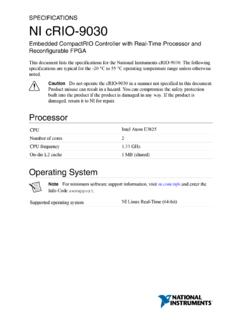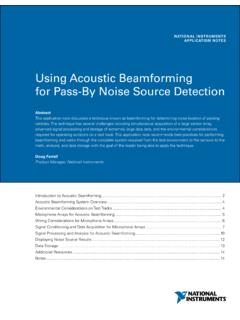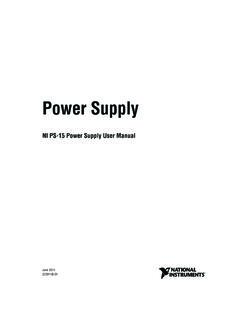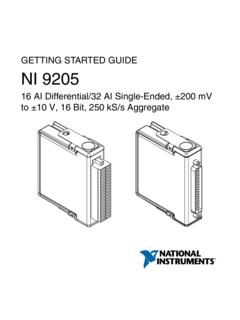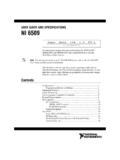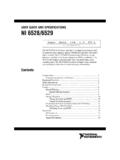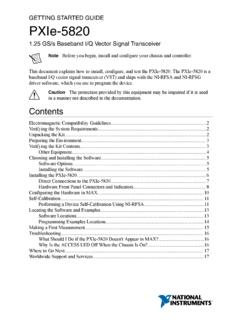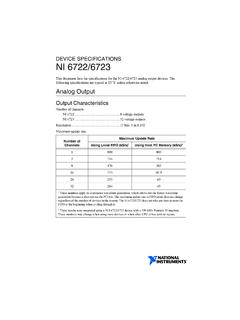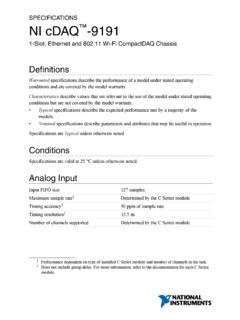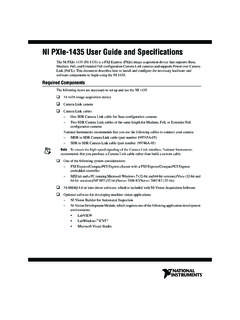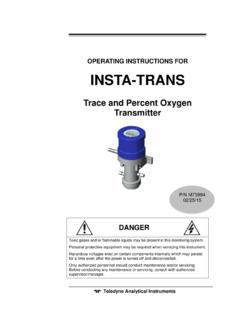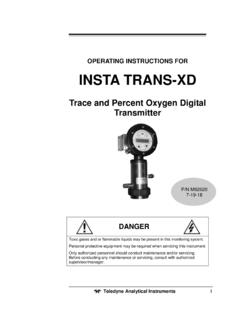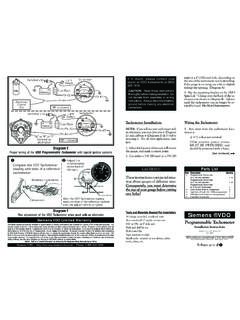Transcription of NI 9421 Getting Started Guide - National Instruments
1 Getting Started Guide . NI 9421. 8-Channel Sinking Digital Input Module This document explains how to connect to the NI 9421. In this document, the NI 9421 with screw terminal, NI 9421 with spring terminal, and NI 9421 with DSUB are referred to inclusively as the NI 9421. Note Before you begin, complete the software and hardware installation procedures in your chassis documentation. Note The guidelines in this document are specific to the NI 9421. The other components in the system might not meet the same safety ratings. Refer to the documentation for each component in the system to determine the safety and EMC ratings for the entire system. Safety Guidelines Operate the NI 9421 only as described in this document. Caution Do not operate the NI 9421 in a manner not specified in this document. Product misuse can result in a hazard. You can compromise the safety protection built into the product if the product is damaged in any 2 | | NI 9421 Getting Started Guide way.
2 If the product is damaged, return it to NI for repair. Safety Guidelines for Hazardous Voltages If hazardous voltages are connected to the device, take the following precautions. A hazardous voltage is a voltage greater than Vpk voltage or 60 VDC to earth ground. You can connect hazardous voltages only to the NI 9421 with screw terminal and the NI 9421 with spring terminal. Do not connect hazardous voltages to the NI 9421 with DSUB. Caution Ensure that hazardous voltage wiring is performed only by qualified personnel adhering to local electrical standards. Caution Do not mix hazardous voltage circuits and human-accessible circuits on the same module. Caution Ensure that devices and circuits connected to the module are properly insulated from human contact. Caution When module terminals are hazardous voltage LIVE (> Vpk/60 VDC), you must ensure that devices and circuits connected to the module are NI 9421 Getting Started Guide | National Instruments | 3.
3 Properly insulated from human contact. You must use the NI 9932 connector backshell kit to ensure that the terminals are not accessible. NI 9421 with Screw/Spring Terminal Safety Voltages Connect only voltages that are within the following limits: .. Channel-to-COM 30 V max Isolation Channel-to-channel .. None Channel-to-earth ground Continuous .. 250 Vrms, Measurement Category II. Withstand .. 2,300 Vrms, verified by a 5 s dielectric withstand test Measurement Category II is for measurements performed on circuits directly connected to the electrical distribution system. This category refers to local-level electrical distribution, such as that provided by a standard wall outlet, for example, 115 V for or 230 V for Europe. 4 | | NI 9421 Getting Started Guide Caution Do not connect the NI 9421 with screw terminal or NI 9421 with spring terminal to signals or use for measurements within Measurement Categories III or IV.
4 NI 9421 with DSUB Safety Voltages Connect only voltages that are within the following limits: .. Channel-to-COM 30 V max Isolation Channel-to-channel .. None Channel-to-earth ground Continuous .. 60 VDC, Measurement Category I. Withstand .. 1,000 Vrms, verified by a 5 s dielectric withstand test Measurement Category I is for measurements performed on circuits not directly connected to the electrical distribution system referred to as MAINS voltage. MAINS is a hazardous live electrical supply system that powers equipment. This category is for measurements of voltages from specially protected secondary circuits. Such voltage measurements include signal levels, special NI 9421 Getting Started Guide | National Instruments | 5. equipment, limited-energy parts of equipment, circuits powered by regulated low-voltage sources, and electronics. Caution Do not connect the NI 9421 with DSUB to signals or use for measurements within Measurement Categories II, III, or IV.
5 Note Measurement Categories CAT I and CAT O are equivalent. These test and measurement circuits are not intended for direct connection to the MAINS building installations of Measurement Categories CAT II, CAT III, or CAT IV. Safety Guidelines for Hazardous Locations The NI 9421 is suitable for use in Class I, Division 2, Groups A, B, C, D, T4 hazardous locations; Class I, Zone 2, AEx nA IIC T4. and Ex nA IIC T4 hazardous locations; and nonhazardous locations only. Follow these guidelines if you are installing the NI 9421 in a potentially explosive environment. Not following these guidelines may result in serious injury or death. Caution Do not disconnect I/O-side wires or connectors unless power has been switched off or the area is known to be nonhazardous. 6 | | NI 9421 Getting Started Guide Caution Do not remove modules unless power has been switched off or the area is known to be nonhazardous.
6 Caution Substitution of components may impair suitability for Class I, Division 2. Caution For Division 2 and Zone 2 applications, install the system in an enclosure rated to at least IP54. as defined by IEC/EN 60079-15. Caution For Division 2 and Zone 2 applications, connected signals must be within the following limits. Capacitance .. F max Special Conditions for Hazardous Locations Use in Europe and Internationally The NI 9421 has been evaluated as Ex nA IIC T4 Gc equipment under DEMKO Certificate No. 03 ATEX 0324020X and is IECEx certified. Each NI 9421 is marked II 3G and is suitable for use in Zone 2 hazardous locations, in ambient temperatures of -40 C Ta 70 C. If you are using the NI 9421. in Gas Group IIC hazardous locations, you must use the device in NI 9421 Getting Started Guide | National Instruments | 7. an NI chassis that has been evaluated as Ex nC IIC T4, Ex IIC. T4, Ex nA IIC T4, or Ex nL IIC T4 equipment.
7 Caution You must make sure that transient disturbances do not exceed 140% of the rated voltage. Caution The system shall only be used in an area of not more than Pollution Degree 2, as defined in IEC 60664-1. Caution The system shall be mounted in an ATEX/IECEx-certified enclosure with a minimum ingress protection rating of at least IP54 as defined in IEC/EN 60079-15. Caution The enclosure must have a door or cover accessible only by the use of a tool. Electromagnetic Compatibility Guidelines This product was tested and complies with the regulatory requirements and limits for electromagnetic compatibility (EMC). stated in the product specifications. These requirements and limits provide reasonable protection against harmful interference 8 | | NI 9421 Getting Started Guide when the product is operated in the intended operational electromagnetic environment. This product is intended for use in industrial locations.
8 However, harmful interference may occur in some installations, when the product is connected to a peripheral device or test object, or if the product is used in residential or commercial areas. To minimize interference with radio and television reception and prevent unacceptable performance degradation, install and use this product in strict accordance with the instructions in the product documentation. Furthermore, any changes or modifications to the product not expressly approved by National Instruments could void your authority to operate it under your local regulatory rules. Special Conditions for Marine Applications Some products are Lloyd's Register (LR) Type Approved for marine (shipboard) applications. To verify Lloyd's Register certification for a product, visit and search for the LR certificate, or look for the Lloyd's Register mark on the product. NI 9421 Getting Started Guide | National Instruments | 9.
9 Caution In order to meet the EMC requirements for marine applications, install the product in a shielded enclosure with shielded and/or filtered power and input/output ports. In addition, take precautions when designing, selecting, and installing measurement probes and cables to ensure that the desired EMC performance is attained. Preparing the Environment Ensure that the environment in which you are using the NI 9421. meets the following specifications. Operating .. temperature -40 C to 70 C. (IEC 60068-2-1, IEC 60068-2-2). Operating .. humidity 10% RH to 90% RH, (IEC 60068-2-78) noncondensing Pollution Degree .. 2. Maximum altitude .. 2,000 m Indoor use only. 10 | | NI 9421 Getting Started Guide Note Refer to the device datasheet on for complete specifications. Connecting the NI 9421. The NI 9421 provides connections for eight digital input channels. NI 9421 Getting Started Guide | National Instruments | 11.
10 Figure 1. NI 9421 Pinout 0 3 0 3. 4 7 4 7. DI0 0 DI0 0. DI1 1 DI1 1. 1 COM. DI2 2 DI2 2 DI0 14. 2 NC. NC 15. DI3 3 DI3 3 3 COM. DI1 16. 4 COM. DI4 4 DI2 17. DI4 4 NC 18. 5 NC. 6 COM. DI5 5 DI5 5 DI3 19. 7 COM. DI4 20. DI6 6 DI6 6 NC 21. 8 NC. 9 COM. DI7 7 DI7 DI5 22. 7 10 COM. DI6 23. NC 8 11 NC. NC 8 NC 24. 12 COM. DI7 25. COM 9 COM 9 13 COM. Note You must use 2-wire ferrules to create a secure connection when connecting more than one wire to a single terminal on the NI 9421 with screw terminal or NI 9421 with spring terminal. 12 | | NI 9421 Getting Started Guide NI 9421 Signals Each channel of the NI 9421 has a DI terminal or pin to which you can connect voltage or current signals. The NI 9421 also has COM, a common terminal or pin that is internally connected to the isolated ground reference of the module. The NI 9421 has sinking inputs, meaning that when the external device drives current or applies voltage to the DI terminal or pin, DI provides a path to COM for the current or voltage.
